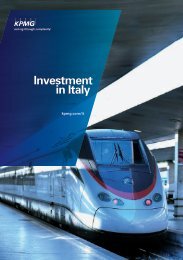Innovation Canada: A Call to Action
Innovation Canada: A Call to Action
Innovation Canada: A Call to Action
Create successful ePaper yourself
Turn your PDF publications into a flip-book with our unique Google optimized e-Paper software.
Filling the GapsThe budgetary implications of the proposedmodel permit considerable flexibility regardingcost sharing between the federal governmentand the external partners. That said, theinstitutes proposed here would have <strong>to</strong> developrobust transition plans <strong>to</strong> ensure initially thateach individual institute is achieving fiscalbalance. These plans would also outlineappropriate metrics of success, the ongoingrealization of which would be a necessarycondition for continued federal contributions <strong>to</strong>their operation. The key <strong>to</strong> success would berequirements that (i) the governance of thebusiness-facing institutes be dominated by theindustry they are intended <strong>to</strong> serve, (ii) the corefederal support be long term and sufficient <strong>to</strong>ensure dependability and quality and (iii) thefunding contributed by business be a sufficientlylarge proportion of the <strong>to</strong>tal budget of eachinstitute <strong>to</strong> ensure business buy-in andcommitment.The devolution of certain of the NRC’s basicresearch activities <strong>to</strong> the university sec<strong>to</strong>r wouldneed <strong>to</strong> be accompanied by ongoing federalsupport, but presumably not significantlydifferent from the current and anticipatedamounts. There would also be significant onetimecosts associated with the transition <strong>to</strong> thenew structure. But these costs should be viewedas a necessary long-term investment in muchimprovedoutcomes for business innovation,driven by more leveraged financing ofcommercially relevant R&D.The Risk Capital GapThe term “risk capital” as used in this reviewrefers <strong>to</strong> funding of innovation-focussedbusinesses from start-up through <strong>to</strong> maturity,when the company is ready <strong>to</strong> access publicfinancial markets or is acquired by another firm(Figure 7.1).Box 7.5 Sec<strong>to</strong>ral Research and <strong>Innovation</strong> StrategiesThe collaborative R&D institutes proposed in Recommendation 4 would have the potential <strong>to</strong>play important roles for tailored, industry-led sec<strong>to</strong>r strategies. The CCA’s report oninnovation and business strategy (CCA 2009) underscores that no Canadian sec<strong>to</strong>r in <strong>Canada</strong>is “average.” Each sec<strong>to</strong>r is characterized by a wide array of features stemming from amultiplicity of social, economic, cultural, his<strong>to</strong>rical and other fac<strong>to</strong>rs. To illustrate, the reportincludes case studies of four sec<strong>to</strong>rs that highlight the great diversity of circumstances. Eachof the case studies can be summarized in a phrase as follows.Au<strong>to</strong> sec<strong>to</strong>r — “weak R&D, but strong productivity”Life sciences — “great promise, but mixed results”Banking — “balancing stability versus radical innovation”Information and communication technologies — “a catalytic role for government.”Just as there is no average sec<strong>to</strong>r in <strong>Canada</strong>, there is no “one size fits all” remedy <strong>to</strong><strong>Canada</strong>’s innovation challenges. Sec<strong>to</strong>r-specific expertise and initiatives are paramount, andthe Panel’s proposed large-scale, industry-directed and co-funded institutes could potentiallyserve as a catalyst in that respect.7-11
















